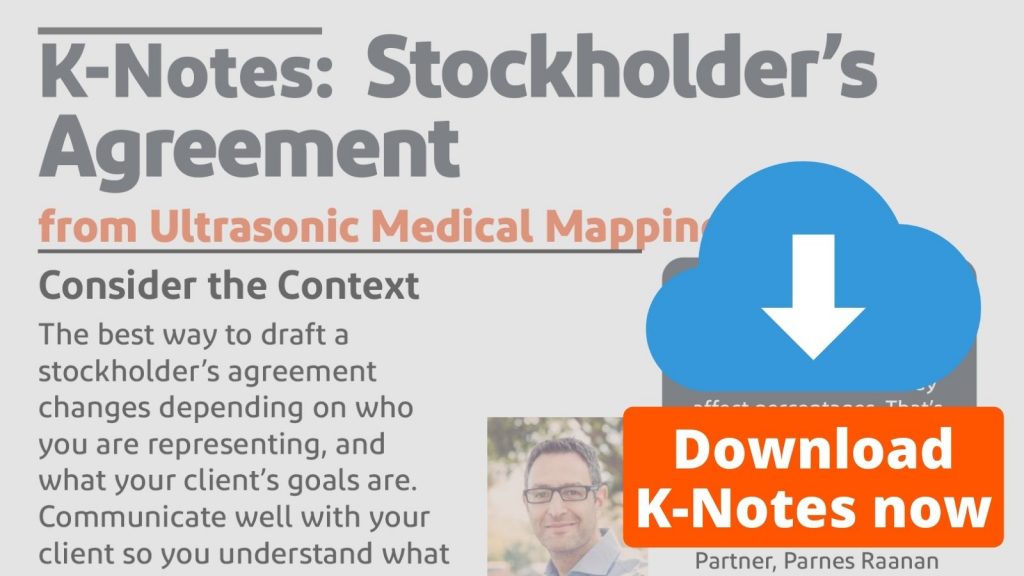International commercial attorney James Raanan tears down a shareholders agreement from Ultrasonic Medical Mapping. James notes the unique context of a shareholders agreement where many of the interested parties aren’t even signing the agreement. He walks through how fiduciary duties change the risks, the complexity of “fairness” in a document like this, and a bit of clumsy math.
Questions in this Episode
- What are the parameters to consider in a supermajority clause?
- Do you need the deadlock clause in a stockholders agreement?
- What does negotiation look like on different sides when it comes to drag along rights?
- What does a well-drafted amendment and modification waiver clause look like?
- What are some general principles to consider in a stockholder’s agreement?
What are Stockholder Agreements all About?
Stockholders agreements are common in financial transactions, and their most unique feature is that they can be multilateral, including more than two parties. It’s fascinating to discuss because every single stockholder has different interests depending on the number of shares they own or their own interests, whether they’re a strategic investor or a financial investor. It comes up frequently in venture capital transactions, joint ventures, and any situation where you are trying to regulate a company’s governance.
Exploring the Supermajority Clause In A Stockholders Agreement
In section 2.02, Voting Arrangements, there are certain actions that companies need to take in their life cycle that require a specific type of approval, particularly when a new investor or a strategic investor comes in. Companies usually want supermajority approvals saying that they cannot take a certain action unless they reach a certain milestone or percentage. And these are usually significant actions that include:
- Settling a lawsuit
- Appointing a CEO
- Firing a CEO
- Changing the accounting rules that the company uses
Supermajority Approval |
|
| Supermajority Approval means with respect to any matter that must be approved by the Board (a) the affirmative vote at a meeting of the board of at least 66% of the entire Board or
(b) the unanimous written consent of the entire Board in lieu of a meeting. “Tag-along Notice” has the meaning set forth in Section 3.04(c). Tag-along Period has the meaning set forth in section 3.04(c). “Tag-along Sale has the meaning set forth in section 3.04(a). |
Interestingly, this clause has a 66% threshold of the board. Let’s see how this could be a problem. There are essentially 2 parameters to consider:
- Who has to make the decision?
If you are representing a financial investor, you might wish to act in your own best interests. The general rule is to give shareholders powers such as supermajority approval for a special decision.
If you are representing the company, it is best to go to the board for the smooth running of the organization and to keep everything honest. The more decisions that come to the board, the better, because it is more efficient and the directors are subject to their fiduciary duties.
- What percentage is required?
The issue with this clause is that it requires 66% approval. In this case, there are only 2 directors which means 100% of the directors. You can’t split somebody in two.
Firstly we need to bear in mind that this becomes more complex in a company which has more shareholders and more directors. And secondly, you have to be careful when you express the percentage as a percentage of the board purely because of the arithmetical reason.
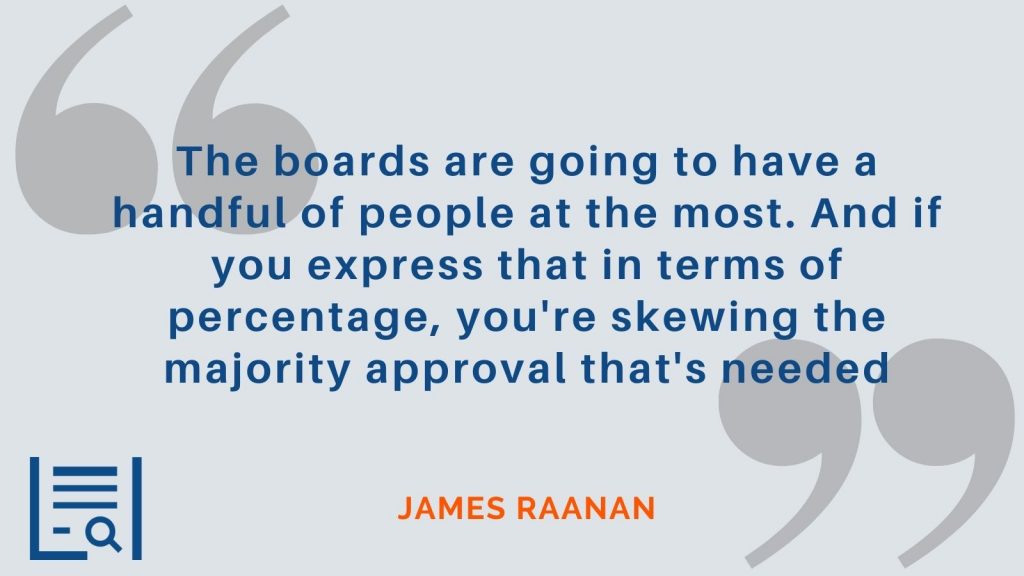
Is A Deadlock Clause Necessary?
These clauses aren’t usually seen in a Stockholders Agreement, but hold your horses. There’s a catch.
Joint ventures or when a large corporation invests in a smaller company are still examples of this. What’s fascinating about this is that they identify three distinct situations:
- Material Change in the business of the company
- Initiating a public offering
- Liquidating the company
When the board cannot agree on problems that have occurred as a result of the above three conditions, which is known as a deadlock, they usually follow a procedure. According to the procedure, if you are the largest stockholder, you can buy out the smallest stockholder at fair market value (the call option), or if you are a minority stockholder, you can compel the majority stockholder to buy you out (the put option).
Section 2.03 Deadlock |
|
| (a) If at two (2) successive meetings of the Board, the Directors are unable to reach a decision by the required vote regarding any Fundamental Matter submitted for consideration by the Board at such meetings (a “Deadlock”), the Board shall refer the matter subject to the Deadlock to the Initial Stockholders, who shall attempt to resolve such matter within twenty (20) Business Days after referral to them of the Deadlocked issue (or, if mutually agreed by the Initial Stockholders, a longer period of time). Any resolution agreed to by the Initial Stockholders shall be final and binding on the Company and the Stockholders. |
In this provision, it appears that the procedure is excessively lengthy, and the practicality of this clause is questionable. However, it’s possible that the drafter did so because he’s effectively buying through this behavior and compelling the parties to act reasonably and reach some sort of agreement. But if it isn’t, three or four months is a long time when dealing with capital markets.
Drag Along: A Draconian Right?
Drag Along rights allow the majority stockholders to force the minority to sell their shares.
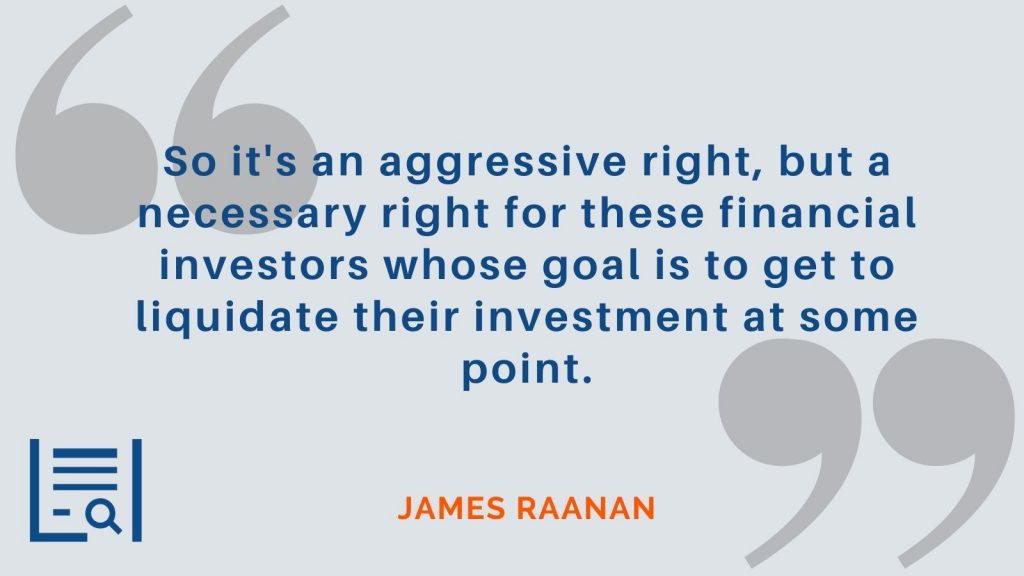
What really draws the attention in this clause is, first of all, the threshold. How large does the majority have to be to force the minority stockholder to sell? In this case, it’s fifty-one percent, which has a certain fairness ring to it, but it’s pretty aggressive to cause 49 percent of the effect to be almost half of the company to sell the shares. And, in most cases, a greater barrier would apply, especially if a corporation had more financial investors.
One of the things that I always look for in an agreement is not necessarily what's in the agreement, it's what's not in the agreement. -James Ranaan #ContractTeardown Click To Tweet
So there’s no quantum in the agreement requiring the offer price to be at a certain level for the minority stockholder to sell out. As a result, you may find that you set a minimum valuation, especially if you have a financial investor. So, unless the company receives a bid of at least $40 million, this shareholder will not be compelled to sell their shares. It is always good to have this when representing a financial investor.
In a private equity situation, on the other hand, they may say, “I don’t want those requirements because if things go wrong, I need to be able to sell this inexpensively and get out of my investment.” There are a variety of reasons why different parties may desire different outcomes.
Pre-emptive Rights: It’s A Contextual Thing
When you provide a shareholder preemptive rights, you’re giving them the right to join in a subsequent investment in the company to keep their pro-rata stake. Pro-rata is defined as the number of shares I own divided by the total number of shares outstanding in the company.
On a fully diluted basis, it refers to the number of new securities intended to be issued as well as the percentage of the company’s outstanding common stock.
A fully diluted basis indicates that I count not only all of the shares that have been distributed to shareholders but also all of the shares that may be distributed to shareholders (options or warrants). Employee stock options, for example, are effectively a right to purchase a share at a future date. In essence, a warrant, which is the same thing as an alternative.
Section 4.01 Pre-emptive Right. |
|
| (a) The Company hereby grants to each Stockholder (each, a “Pre-emptive Stockholder”) the right to purchase its pro rata portion of any new Common Stock (other than any Excluded Securities)(the “New Securities”) that the Company may from time to time propose to issue or sell to any party.
(i) the number of New Securities proposed to be issued and the percentage of the Company’s outstanding Common Stock, on a fully diluted basis, that such issuance would represent; |
In a business, there will be multiple investors. Some of those investors may decide not to take advantage of their preemptive rights. And you can acquire the pro-rata portions of other investors if you choose an over-allotment option over a lengthier option. So, if I hold 20% and you hold 20%, we can each increase our stakes by 20% in the next round. However, you are not required to use your 20%. This enables me to purchase your 20%.
If you’re the general counsel for the company, you should take a step back and try not to encourage it because it could lead to one investor dominating the company if they have significantly more and deeper pockets than the other investors. So it’s a matter of context, but it’s something to look out for.
Amendment & Modification Waiver: Are you Doing it Right?
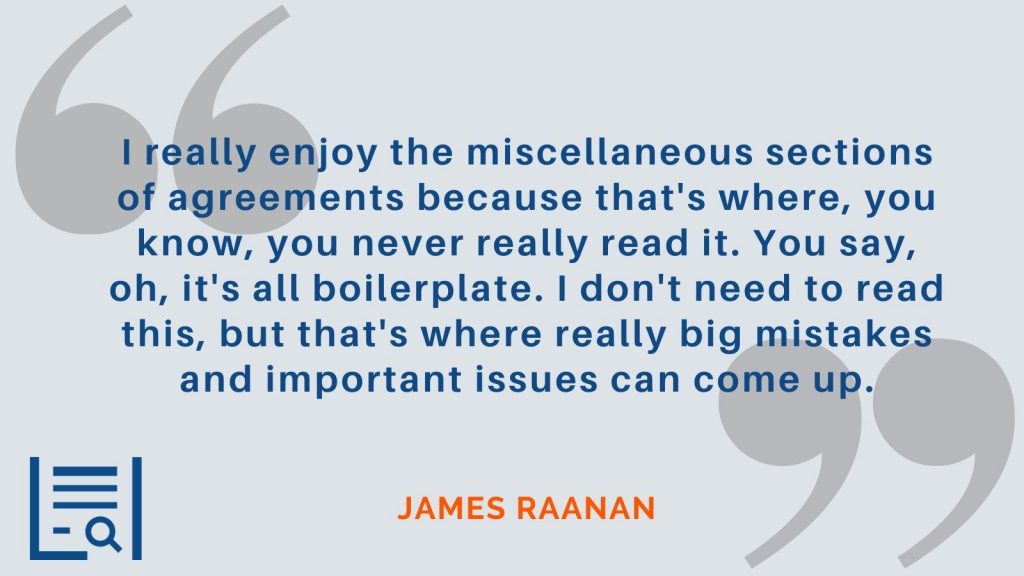
When it comes to clauses like these you need to remember the number of parties that are a part of the particular agreement.
Any party that comes in after the stockholder’s agreement is likely going to want to change it. They would wish to have their own rights of first refusal, their own voting rights, etc. Giving this levy just creates a worse position for you as you might not be able to reach an agreement at all.
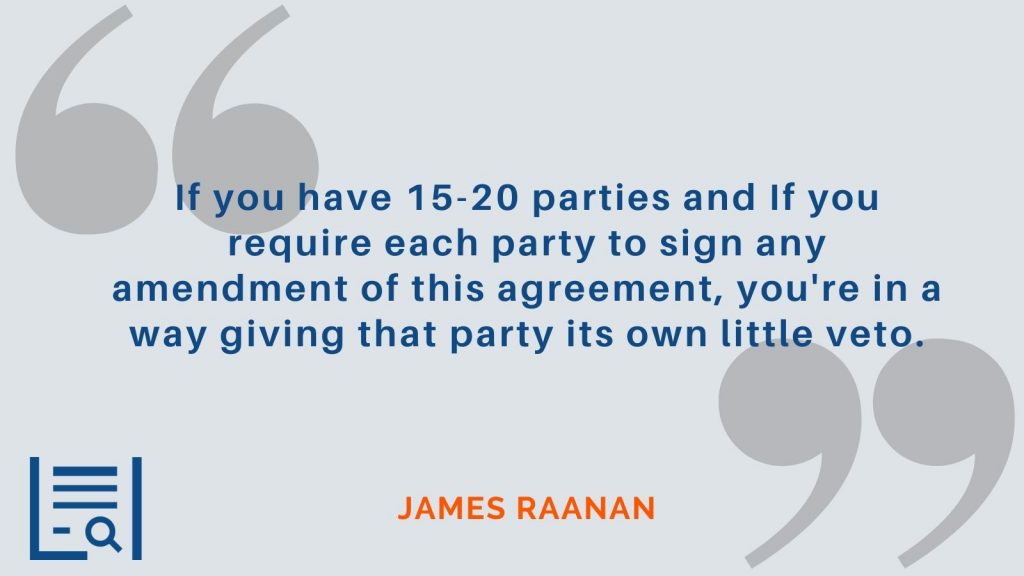
A new investor can hold up any further change to this agreement. Depending on who you’re representing it is better to look at a higher threshold. You can have investors from a certain class or a particular majority or a particular constituency of common shareholders or founders and a particular constituency of investors to consent. You don’t necessarily need everybody’s consent.
A General Principle to look out for When Drafting a Stockholders Agreement
If you are representing the investor, then you have to understand their goals and if their goal is to encash their investments at a certain point in time, as lawyers, we need to focus on the provisions that will enable them to do so.
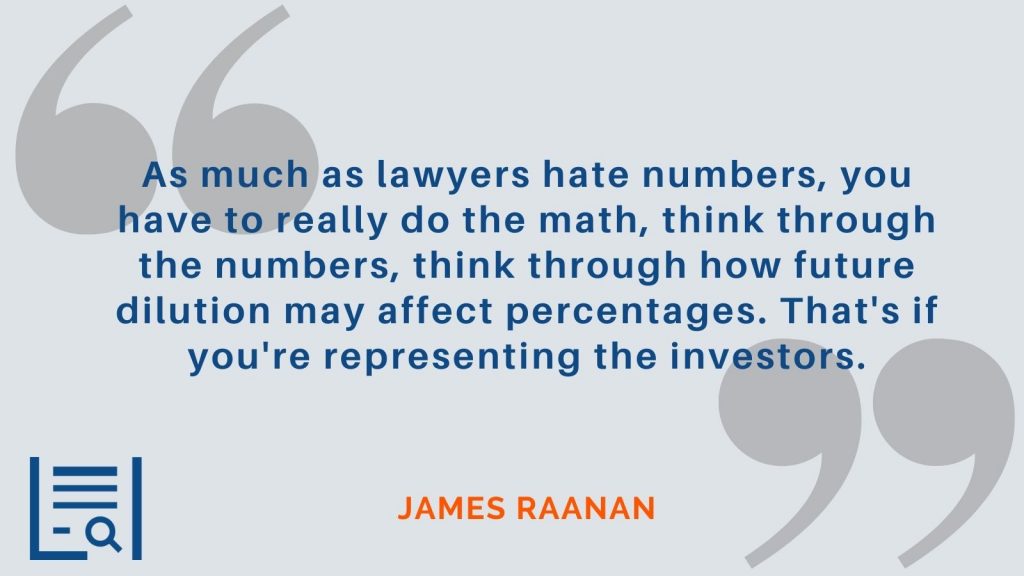
If you are representing the company, you want future fundraisings to be as easy as possible. You want the company to make decisions with minimal encumbrances and bring the focus to deemphasizing anything that requires a large constituency of a vote. It’s a good idea to aim for lower voting thresholds and shorter procedures. As a result, it’s extremely context-driven.
In the stockholder’s agreement, you're creating a coalition and you have to come up with the most sensible governance arrangement that works for the largest number of constituents. - James Ranaan #ContractTeardown Click To Tweet
Final Thoughts
Stockholder agreements are mostly context-driven. It’s best to examine the context you are operating in and then act accordingly.
If you are representing the investor it’s critical to think about their rights and how the agreement may impact their future rights. It’s best to get a clear idea of their expectations before negotiating.
If you are representing the company the best practice would be to talk to the board and see the level of freedom and levy that the company may give in terms of shareholding and the importance of the rights vested in board members.
It’s always good to understand the goals of each party and knowing some business terms along with what we’ve discussed including drag along, preemptive, and other rights can be useful when drafting and negotiating a Stockholders Agreement.
Show Notes
THE CONTRACT: Ultrasonic Medical Mapping’s Stockholders Agreement
THE GUEST: James’ primary experience has been in the telecommunications and Fintech/Payments industries, working with traditional and disruptive businesses. Since graduating in law from the University of Manchester in 1996, James has accumulated over 20 years of legal experience across a diverse landscape. Prior to his position at IDT, James worked at the prominent Israeli law firm, Yigal Arnon & Co., where he developed expertise in venture capital financing, US securities, and M&A during years 1998 to 2003. James is a member of the bar in New York and Israel. He can be found around the internet, and reached at James@parnesraaanan.com.
THE HOST: Mike Whelan is the author of Lawyer Forward: Finding Your Place in the Future of Law and host of the Lawyer Forward community. Learn more about his work for attorneys at www.lawyerforward.com.
If you are interested in being a guest on Contract Teardown, please email us at community@lawinsider.com.
Transcript
James Ranaan [00:00:00] There are different interests from every single stockholder.
Intro Voice [00:00:05] Welcome to the Contract Teardown Show from Law Insider, where legal experts tear down contracts from some of the most well-known companies and high profile executives around the world.
Mike Whelan [00:00:19] In this episode, international commercial attorney James Ranaan tears down a shareholders agreement from ultrasonic medical mapping. James notes the unique context of a shareholder’s agreement where many of the interested parties aren’t even signing the agreement. He walks through how fiduciary duties change the risks, the complexity of fairness in a document like this, and a bit of clumsy math. So let’s tear it down.
Mike Whelan [00:00:46] Hey, everybody. Welcome back to the Contract Teardown Show from Law Insider. I’m Mike Whelen. The purpose in this show is to do exactly what it sounds like. We take contracts and we beat them up. Sometimes we’re nice, but most of the time we’re not. We hang out with smart friends who beat these contracts up today. I’ve got a James Ranaan coming to us from Tel Aviv today and we are talking about a stockholder agreement. James, how are you doing today?
James Ranaan [00:01:15] Hey, Mike, I’m good. Thanks for having me on. Great to be here.
Mike Whelan [00:01:19] Absolutely glad to have you. And this document. James, this stockholder agreement, it’s coming up a lot. Let me show you guys, the one we’re using. It is it’s among ultrasonic medical mapping inc. As you can see, I’m pulling this from Law Insider. So you see live links throughout the document that go to other parts of law, insider for comparative language, other definitions that look similar. But anyway, this is the document that we’re going through. So, James, let me come back to you. Why are we talking about this agreement, this particular one, when are lawyer’s going to see this kind of document.
James Ranaan [00:01:53] So this stockholder’s agreement has come up a lot in financing transactions. And the interesting thing about stockholder’s agreement, as opposed to in many ways, a lot of the agreements that have been on the show is that the multilateral right is not just two parties, it could be many different parties. And so I think it’s an interesting agreement to talk about because there are different interests from every single stockholder, depending on where they sit in terms of the number of shares they hold or in terms of their their own interests, whether they are a strategic investor or a financial investor, and comes up a lot in venture capital transactions, joint ventures, and really any situation where you’re trying to regulate the governance of a company.
Mike Whelan [00:02:43] Very good. And why you why why are we talking to you, James? What’s your background? Tell me a bit about your practice.
James Ranaan [00:02:50] So as you can guess from the accent, I’m originally from the U.K., from England, and then I emigrated to Israel in the in the early in the mid 90s and was received a baptism of fire into the world of dotcom. And then, you know, at that time in Israel, when the startup nation was at its infancy, anybody who could string a sentence together in English could could get a job in a corporate firm. And so I had the fortune of doing a huge number of venture capital transactions in those early years. And then as my career developed and the dotcom bubble burst, I moved over to become a general counsel in a large US telecoms company where I worked for about 18 years, became admitted to the bar in New York. So I’m admitted in New York and in Tel Aviv. And I have the English background and I’ve done a lot of this from different perspectives, both from the the large corporate, but also the small startup and then the venture capital fund. So I hope in some way I’m able to bring those perspectives to bear.
Mike Whelan [00:04:05] Very cool. You should have told me at the time that you just needed to speak English for a job. I would have flown out if I have one skill, it’s talk in English. We are going to go through this document, guys, and we’re going to start a very early. They do have a definition section early. And there is a definition in here, James, that was bugging you. The supermajority approval. If I if I scroll down to that and get some of this language, it means with respect to any matter that must be approved by the board, the affirmative vote at a meeting of the board of at least sixty six percent of the entire board, et cetera. What’s bugging you about this particular definition?
James Ranaan [00:04:46] So first of all, this definition has to be read in conjunction with another section, which is Section two point zero two and Section two point zero two lists, a number of different decisions or actions that a company may want to take in its life cycle, which require a specific type of approval. So, as you know, the default, if you didn’t do anything in most countries and in most most companies is that the decisions come to the board. Certain decisions have to be brought to the shareholders and depart from some peculiarities. For the most part, majority approval is needed. But in a acerca, in circumstances such as these, where you have outside investors coming in or maybe a strategic investor coming in, in the context of the stockholder agreement, they will want to specify certain supermajority approvals that they will say unless we reach this percentage, the the particular action cannot be taken and the actions that typically actions which are significant actions. So, for example, settling a lawsuit, appointing a CEO, firing a CEO, changing the accounting rules that the company uses. So significant decisions. And what was interesting about this was that the threshold is sixty six percent of the board. And that’s interesting for a couple of reasons. So whenever I look at the super majority, I look at two parameters. One is who has to make the decision? Is it the board or the shareholders? And after I’ve decided that the question is what percentage is required, so let’s back up to whether it’s the shareholder or the board, why would you want the board, the board to be subject to the approval if you the the company or maybe a smaller shareholder or the the the maybe not the financial shareholder? The more decisions you can you can have coming to the board, potentially the better, because it’s more efficient and because then the directors are subject to their fiduciary duties. If you are a financial investor who may want to take decisions for its own self-interest, not because they’re bad guys, but because they’re in the moneymaking business, they may want to legitimately take takes an interest and takes the decisions in their own interest. And that would potentially compromise. That position as a as a fiduciary, so I always, if I’m representing the investor, prefer that the the the rights such as this, the supermajority approval for a special decision be allocate to the shareholders. If I’m representing the company, then for the smooth running of the company and to keep everything, keep people, if you like, a little bit more honest, I like it to come to the board. So that’s just a nuance. The second question is then, what should the percentage be? Now, this company and I don’t know anything about the company and I’m always watching your shows and I’m always kind of careful not to second guess the draft because I’m sure they have very good reasons for everything. That’s my people. And this is, for the most part, very well crafted agreement.
Mike Whelan [00:08:19] I like your optimism about the drafting attorneys and every one of these cases. But yes, go on.
James Ranaan [00:08:27] What is a little bit of a hedge in case a very well done do so in this company, there are two directors. So if you say you need sixty six percent of the directors, that means you need one hundred percent of the directors. You can’t split somebody into two. So and this goes back to the law school. Right. The reason we go to law school is because we’re better at English, do the math. And so one we have to bear in mind, and this becomes more complex in a in a company which has more shareholders and more directors. But I think do think you have to be careful when you express the percentage as a percentage of the board purely because of that arithmetical reason. Right. The boards are going to have a handful of people at the most. And if you express that in terms of percentage, you’re skewing the majority approval that’s needed. So that was what was today on this particular class.
Mike Whelan [00:09:24] Hey, everybody, I’m Mike Whalen, I hope you’re enjoying this episode of the Contract Teardown Show real quick. I want to ask you to do me you really a quick favor. Look down below. You’ll see a discount code to join the Law Insider premium subscription. When you do that, you get access to more content like this. You’ll see webinars, daily tips on contract drafting, not to mention access to the world’s largest database of sample contracts and clauses. It will help you write better contracts faster if you want to do it. Right now, there’s a code below. So get there. Also, if you’re part of a larger team, if you’re in-house or in a law firm, just email us we’re at sales@lawinsider.com will make sure you get a deal as well. Come join us in the community. The code is below. Let’s get back to the show.
Mike Whelan [00:10:10] Yeah. And I you know, speaking of voting, jumping down to two or three, it talks about deadlock. And specifically, if you have two successive meetings and the directors can’t reach the decision by that vote threshold, what do we do? Two, three goes on for about a page. What do you think about this section?
James Ranaan [00:10:31] I actually thought this was a fascinating section and one that you really don’t see very much in the stockholders agreements, you see it, if you see it, you’ll typically see it in a joint venture scenario where you have two fairly evenly matched sides or in a strategic investor where you maybe have a large corporate investor into a smaller company, you don’t typically see where financial investors such as venture funds or private equity funds will invest in a company. What’s interesting about this is they call out three specific types of issues, which I think one is a material change in the in the business of the company. Another one is initiating a public offering and the final one is liquidating the company. So if the company was to take any of these three actions and the board are unable to, as you correctly said, reach an agreement after a couple of goes at it, then they go through this procedure. And what the procedure does is it says if you’re the largest stockholder stockholder, then you can buy me the smallest stockholder and you can buy me out at a price which is equal to the fair market value. And conversely, if you’re the smaller stockholder, what they call it, the minority stockholder, you can force the majority stockholder to buy you the smallest stockholder. And so there’s a call option and there’s a put option. What I think is interesting in this particular clause and quite challenging is if you actually run through the various sections here and each step of the way ends up really being a procedure involving 20 business days, 15 business days and what than what they really set up as this procedure where from starting at the initial board meeting where there is no agreement, one party has to notify the other, there’s no agreement. They wish to exercise the procedure. Then the next step is the other party responds and then the other party responds to that response. And then they have to go and get a third party appraiser to create an appraisal within 30 days. So if you think. And I’m deliberately paraphrasing here, but if you think that this somebody wanted to suggest that I bring an action, that an initial public offering should take place or be approved on May the 18th, it could be well into September. If you follow this through before you get to the to the to the to the state where you actually exercise the right to to buy the other party out. So that’s one observation is that I think it’s an interesting provision, but I think that the procedure is so long that I question whether it’s really practical. That may be a reason why the draft drafted it that way, because he’s effectively buying through this behavior is forcing the parties to act rationally and to come to some kind of agreement. So it may be may be deliberate, but if it isn’t, then it just, you know, three, four months is a very long time when you’re dealing with capital markets or decisions like this. There was one mind,
Mike Whelan [00:13:53] this transaction you’re actually trying to make happen. It might actually undermine that. But but to your point, if there’s nothing going on now.
James Ranaan [00:14:01] Yeah, no, absolutely. If you’re a third party buyer or you’re an underwriter in an IPO, you’re not going to want to sit around and wait for all of this to happen. And it ends up giving one party a lot of power over the other party. But as we spoke about before, because this company is effectively a two board, two person board, it may be necessary because if you unresolved that deadlock, then you’re not going to go anywhere. So it was it was it’s an interesting provision, Section IX of this provision, I think, in Section two, three. States, they each stockholders shall take all actions as may be reasonably necessary to consummate the sale contemplated by this Section two or three, including entering into agreements and delivering certificates and instruments and consensus may be deemed necessary or appropriate. So the potential issue you have with that provision is it’s what I would call an agreement to agree. So. You go through the whole procedure and you imagine that the majority stockholder presents an agreement for the minority stockholder to sign and then the minority stockholder has to sign that agreement. Well, it’s a little bit too vague in terms of what the agreement says, but what if that agreement says, I’m going to give you all my shares, you know, I’m going to give you all my shares, but then I’m going to give you a 50 percent bonus or you’re going to give me a 50 percent bonus. If you sell them on down the road or you refuse to give any representations or warranties on your shares, or it could be a million different things that might be in that agreement. So usually what you might see in a deadlock provision is much more specificity around what the selling stockholder will have to put in that agreement. Often, typically just be representations about the title the shareholder has. That seller has their own shares because that’s something they they should always be able to represent to. So that was an interesting something that just kind of came up that would make this procedure a little more difficult to accomplish if you went through the whole several, several, 20, 30, 15 day procedures
Mike Whelan [00:16:25] moving down to three or three talks about the drag along rights. Educate me about this section and what you do and don’t like about whether it effectively does with this drag along the rights section is meant to do.
James Ranaan [00:16:39] So so along provisions of something that crept into into practice, certainly since I would say that the private equity and venture capital from the 80s onwards became popular ways of raising capital, and they are built to cater for a situation where a minority stockholder may not want to sell their shares. But that may be an offer from a third party to buy all of the shares of the company. So let’s say a big behemoth comes, sees the startup and says, OK, I would like to buy this company. And the venture capital guy says, that’s great. You know, I hold 60 percent of the company and the and the big behemoth says, well, I don’t just want to buy 60 percent because I don’t want to be dealing with your minority stockholders. I’d like to buy everything. So then we have the drag-a-long, which allows the majority stockholders to force the minority to sell their shares. So it’s a pretty draconian. Right. Imagine somebody’s going to be living in a condo and somebody just because your neighbor wants to sell the condo, he can force you to sell the condo as well. So it’s it’s an aggressive riprap, but a necessary right for these financial investors whose goal is to get to liquidate their investment at some point. So what is was troubling me about this causal clause, or rather what drew my attention was, first of all, the threshold. So we spoke about this before, about when we were talking about super majority is how large does the majority have to be in order to force the minority stockholder to sell? In this case, it’s fifty one percent, which that has a certain fairness ring to it, but it’s pretty aggressive to cause 49 percent of the effect be almost half of the company to sell the shares. So, again, I don’t know this company and there may be some good reasons for it, but that is quite aggressive. And typically you would see a higher threshold, particularly if there were more financial investors in a company. The other the other provision that you often see in these types of agreements and you don’t see here. And as an aside, one of the things that I always look for in an agreement is not necessarily what’s in the agreement, it’s what’s not in the agreement. So what’s not in the agreement is a quantum which requires the offer price to be at a certain level in order to cause the minority stockholder to sell out. So you may you often see, particularly if you have a financial investor, will specify a certain minimum valuation. So if the company doesn’t receive an offer for at least 40 million dollars, then this shareholder won’t be required to sell their shares. So that’s not here. It doesn’t mean it’s not wrong for being here, but that’s typically something. If I was representing a financial investor, I would always want to see that here. Conversely, in a private equity scenario, they may say, know one of those requirements, because if things are going really badly, I need to be able to to sell this cheaply and get out of my investment. So there are all different constituent reasons why different parties may want different things. But that’s just one of the things to look for.
Mike Whelan [00:20:15] Got it. And jumping down to four one talking about the preemptive right, it talks about each stockholder giving it the right to purchase its pro-rata portion of any new common stock that the company may from time to time supposed to issue or sell to any party. What do you think about this section? Do you like the language in the preemptive rights section?
James Ranaan [00:20:36] So this is this is a fairly typical provision, but there are a couple of elements that jumped out. One was in Section four or one, the one where you can scroll down to that. But take a step back for a second. When you you are offering preemptive rights to a shareholder, as you correctly said, it’s the right to participate in an investment in the subsequent investment in the company in order to maintain your pro rata share. The way that you define pro rata intuitively is the shares I hold divided by all of the shares outstanding in the company, they use a particular term of which people in the business will be very familiar with when they refer to the number of new securities proposed to be issued and the percentage of the company’s outstanding common stock on a fully diluted basis. So fully diluted basis means is in my denominator. I count not only all of the shares that have been already given out to shareholders, but all of the shares that may be given out to shareholders, when I say may be given out, it would be options or warrants. So, for example, employee stock options is effectively a right to purchase a share at a future time. A warrant, which is really the same thing, is as an option in essence. But usually given to an investor is the right to purchase a share of the company at a future time. So you may only have given out one hundred shares, but there may be. Ten employee stock options. So if so, in order to really understand what your pro rata portion of the company is, then you would use one hundred and ten as opposed to just a hundred. So you’re holding 10. You’re holding 10 over one hundred and ten. Not today. So that math can significantly change things. And why and sometimes you see these words fully diluted basis included and sometimes you don’t see them included. The reason why sometimes you may not want to have them in there will be at least be very careful about them is what you have what are called out to the money options or after the money warrants. So if in my theoretical startup I raised money at five million dollars and I issued warrants at that time to the investor to purchase shares, one hundred million dollar valuation, but now things have not gone so well. The next time I’m raising money, I’m raising money at a three money, three million dollar free money valuation, which means that my value has gone down and that those those warrants, one hundred million dollars are really worth very little because nobody is going to pay at a valuation of one hundred million dollars for buying shares in this company. Yeah, that goes into this calculation of full dilution and artificially inflated the number of shares there are in the company and may mean that I have a smaller pro rata share of the of the whole. So you have to be very careful about the arithmetic when you’re dealing with this particular formulation. So that’s as far as the the how much what what is the portion of the other, which I think is interesting, is in Section four 01 D.
James Ranaan [00:24:32] And this refers maybe I’ll read it no later than five business days following the expiration of the exercise period, the company shall notify each preemptive stockholder in writing of the new securities that preemptive stockholder has agreed to purchase. And that excuse me, they referred to it, the defined term they give it is an over allotment notice, but what is referring to is a. is an over allottment an option. So they are going to be several investors in a company. Some of those investors may choose not to exercise that preemptive rights. And what an overall option over a longer an option allows you to do is to buy the pro-rata portions of other investors. So if I hold 20 percent and you hold 20 percent, we can each by 20 percent each of the of the new round. But you may not elect to exercise your 20 percent. This allows me to buy your 20 percent. And in essence, it’s not. If you’re an investor, it’s a nice right to have, particularly if you have deep pockets because it gives you a way of hedging so that you can continuing continually increase your percentage in the company, even over your pro-rata portion. Sometimes if you’re the company counsel, you may take a step back and try not to encourage it because it could lead to one particular investor dominating the company if they have a lot more and deeper pockets than the other investors. So it’s really a contextual thing, but it’s it’s something to be to to look out for.
Mike Whelan [00:26:15] All right. Well, moving to the last section we’re going to talk about is down to nine point one, one amendment and modification waiver. This agreement may only be amended, modified or supplemented by an agreement in writing signed by each party here to et cetera, seems to be overlapping with some of the interesting questions that you introduced about how many parties are actually involved in this kind of document. Talk to me about nine point one one and what you like and don’t like.
James Ranaan [00:26:45] So one of the as an aside, one of the things I like to do, and I don’t know if this reflects on me is utter geek, is I really enjoy the miscellaneous sections of agreements because that’s where, you know, when you’re young, you never really read it. You say, oh, it’s all boilerplate. I don’t need to read this, but that’s where really big mistakes and important issues can come up. And again, I’m not saying this is a mistake, but here this agreement and a stockholder agreement could have 20, 30 parties in it. It could have three or four parties in it could have two parties in it. If you if you require each party to sign any amendment of this agreement, you’re in a way giving that party its own little veto. Right. Over future financing, because any party that is going to come in after this particular stockholders agreement is likely is going to want to change the stockholder agreement. They’re going to want their own preamps to rise. They’re going to want to be part of the stockholder agreement, their own rights of first refusal and their own vote rights. And if you don’t have the ability to easily change this agreement, then you are going to have to create all kinds of weird side agreements. Or worse still, you may not be able to reach an agreement at all. So if you could just imagine that we kind of go back to the numbers and you have your venture investor who may have twenty five percent of the company, a couple of founders, you have 40 percent of the company, some other smaller seed or angel investors. Then you may have one little family investor. You’ve got your brother to invest in the company. You put in five thousand dollars. And suddenly because this agreement says each party here, too, needs to agree to an amendment of this agreement, your brother can hold up any further change to this agreement. And what you would really want to see, again, depending on who you’re representing, is a higher threshold. So you would have maybe all invested a particular class or a particular majority or a particular constituency of common shareholders or founders and a particular constituency of investors so that you can change it. You don’t necessarily need everybody’s consent.
Mike Whelan [00:29:08] What’s interesting to me and as I as we wrap this up, I’m trying to pull out general principles. You see, with a lot of these agreements, when people go out and they get these sort of stock agreements that they find wherever they find them, sometimes they’re overengineered. For the context a little bit, it seems like I don’t know if I’m pulling out general principles. There seem to be some big company things happening with this small company engagement. What kind of general principles? If I’m a drafter, can you pull from this kind of document lessons that we might be able to apply to another context?
James Ranaan [00:29:40] So I think the main thing is always really deeply trying to understand who you’re representing. It sounds obvious, but if you’re representing a financial investor, then you have to understand what their goals, if their goals are really to be able to look to to get out to their investment at some point, then you have to be focusing on the provisions which are going to give them the ability to do that. And you have to as much as lawyers hate numbers, you have to really do the math, think through the numbers, think through how future dilution may affect percentages. That’s if you’re representing the investors. If you’re representing the company and your company counsel, you want a future fundraising’s to be as easy as possible. You want the company to make decisions with minimal encumbrances. So you want to be deemphasizing anything which requires a large constituency of a vote. You want the voting thresholds to be lower. You want people to get the procedures to be to be shorter. So it’s really so context driven. Almost, I would say is if you’re creating a constituency of, you know, a government or a constituency of politicians, which where I come from is where we’ve not had gone for a couple of years, creating coalitions is a very challenging exercise. But that’s what you’re doing in the stockholders agreement. You’re creating a coalition and you have to come up with the most sensible governance arrangement that works for the largest number of constituents.
Mike Whelan [00:31:18] Yeah, and it’s common with big deals like this. I think the cliche is that the contract becomes the client that we get so focused on getting this document done that we start to let the document lead our decisions as opposed to the other way around. Well, I appreciate your context on that and and your experience. It’s very helpful in understanding these kind of documents. If people want to follow up with you to learn more about what you do and how to manage documents, deals like this, what’s the best way to reach out to James?
James Ranaan [00:31:44] So the best way is you could just Google me, James Ranaan, or my my firm partners, and you will find me some. My email address is James@parnesraaanan.com. There aren’t many James Ranaan in the world, so you’ll find me.
Mike Whelan [00:32:04] Awesome. And I appreciate that. We’ll make sure to include that in the show notes. If you guys go to lawinsider.com/resources, you’ll find it there. Also, if you want to be on the show to tear down a document and be mean to the occasional, all the cool kids are doing it. Just email us at community@lawinsider.com. We’ll make sure to give you a place to have that conversation. James, thanks again for being with us. And we will see you guys on the next episode of the Contract Teardown Show. Thank you.


